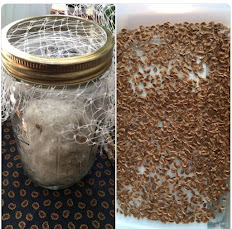 |
| Butterfly Weed seeds
(Asclepias tuberosa)
Photo -C. Kagan |
Milkweed seeds require cold stratification. Here's what that means. In nature milkweed plants scatter their seeds in late autumn when the coming cold would kill any seedlings that germinated. Milkweed seeds are programmed to delay germination. Exposure to winter temperatures soften or crack their hard outer shells. In late spring, as temperatures rise, their dormancy is broken and they will start to germinate. Many species of milkweed are quite easy to grow from seed.
Harvesting your seed
You will find milkweed seeds in the pod, also called a follicle. They are attached
to white, silky, filament-like hairs known as the coma (coh-ma). As the
follicles ripen and split open in the fall, the seeds are revealed on the inside of the follicle. If not harvested, the coma will help seeds be wind-blown to scatter in a wide area.
Seeds will need to be separated from from the coma. Here’s a great tip from Kitty Mao (posted on The Beautiful Monarch FB page October 2017):
“My ‘Low-tech’ Milkweed seed separator: I dislike having special one-time-use gadgets, so I wanted to pass this idea along. You'll need 4 or 5 nickels (coins), a wide-mouth Ball jar with the metal rim, an old onion plastic net and a container to catch the seeds. Throw a couple handfuls of loosened fluff/seed pods in the jar with the coins, double up the net on top of the jar to ensure you have some smaller holes, screw on the lid, then turn upside down and shake out the seeds. Repeat as necessary. (It took me 5 minutes to collect my things and shake out 1/2 cup of Common Milkweed seeds...less time than this post!)”
Fall Planting in the Garden: Many species of milkweed are quite easy to grow from seed. Head outside in the autumn, or even in the early winter. Separate the seeds from the coma and sprinkle the seeds around the garden. Burying the seeds can reduce germination rates since milkweed seeds need light to germinate. Just drop the seeds in the garden and press them down with your hand. Once you've sprinkled the seeds over the soil there's nothing else to do but wait.
In spring, they'll germinate and begin to grow. Be sure the new plants stay well-watered until they're established. Milkweeds are hardy plants that will survive with very little care. Once the seedlings are a few inches tall, you can transplant them to different areas of the garden. [If you want to transplant, move them before they get too big as the root system starts to dig in early.] (Penn State Extension)
Spring Seed Starting: If you want to start seeds in the spring, separate them from the coma and store them in a cool area before until you are ready to cold stratify them to copy the nature process as noted above.
In February, carefully place seeds between moist paper towels to be refrigerated for 3-6 weeks before planting. At that time they can be planted. Peat pots make transplanting later easier. Prepare the pot and and gently water until damp. Place a few seeds on top and gently press down with your finger as they need light to germinate. Water gently, as needed, from the bottom. To prevent fungus, don't overwater. They should sprout in about 10-15 days.
Put your pots in a sunny window, greenhouse, or under a grow light. These should germinate and sprout within 10-15 days after planting. Plant out in the garden after last freeze date. It is best to transplant milkweed in the spring when the plant is small. Transplant on a day that is cloudy or during the cooler morning/evening hours. This will make it less stressful on the plant.
Winter Sowing - Outdoor Germination: Winter sowing is planting seeds outdoors in a protected container during winter. The container remains outdoors until the seedlings emerge in the spring.
The best time to winter sow perennials and annuals is generally December to March depending on the weather conditions in your area. These seeds receive a consistent period of moist, cold temperatures before germination occurs in spring. This is ideal for milkweed seeds.
Remember, when you place the seeds in the containers, they need light to germinate.
Carol Kagan, Master Gardener
Other Resources from Save Our Monarch Organization
Save Our Monarchs Organization has detailed information on growing milkweed seeds indoors.
Save Our Monarchs - Part 1 - outdoor direct sowing and prep for winter sowing-
Save Our Monarchs - Part 2 - planting milkweed outside/ winter sowing step by step- Remember they need light to germinate when you place the seeds on the soil.
~ ~ ~ ~
HERB SAMPLER Second Edition
Buy one for yourself and consider getting a few more as the winter holidays approach – hostess gifts, housewarming and holiday presents.










No comments:
Post a Comment